
Podcast: Dark Matter Maps
What’s the Universe made of? Don’t worry if you don’t have a clue, astronomers don’t either. The Universe is dominated by a mysterious dark matter that seems to form the true mass of a galaxy, not the regular matter – like stars and planets – that we can actually see. Dr. James Jee from Johns Hopkins University used the Hubble Space Telescope to create a detailed map of dark matter concentrations around two galaxies. And astronomers just got some new clues.
Continue reading “Podcast: Dark Matter Maps”
Astrophoto: Contrail Shadow by Rick Gatley
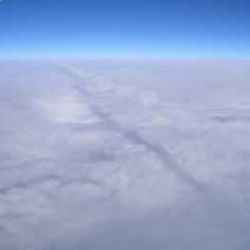
Image credit: Rick Gatley. Click to enlarge
Astrophoto: M42 by Shahriar Davoodian
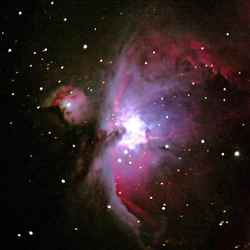
Image credit: Shahriar Davoodian. Click to enlarge
Gaps in Saturn’s Rings
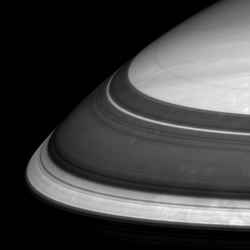
Gaps in Saturn’s rings. Image credit: NASA/JPL/SSI Click to enlarge
Saturn’s rings throw imposing shadows and relegate parts of the planet’s northern regions to darkness. Three thin and bright arcs in this scene represent three well-known gaps in the immense ring system. From bottom to top here (and widest to thinnest) they are the Cassini Division, the Encke Gap and the Keeler Gap.
The image was taken in infrared light (752 nanometers) using the Cassini spacecraft wide-angle camera on Oct. 29, 2005, at a distance of approximately 446,000 kilometers (277,000 miles) from Saturn. The image scale is 23 kilometers (14 miles) per pixel. The image was contrast enhanced to improve visibility of features in the atmosphere.
The Cassini-Huygens mission is a cooperative project of NASA, the European Space Agency and the Italian Space Agency. The Jet Propulsion Laboratory, a division of the California Institute of Technology in Pasadena, manages the mission for NASA’s Science Mission Directorate, Washington, D.C. The Cassini orbiter and its two onboard cameras were designed, developed and assembled at JPL. The imaging operations center is based at the Space Science Institute in Boulder, Colo.
For more information about the Cassini-Huygens mission visit http://saturn.jpl.nasa.gov . The Cassini imaging team homepage is at http://ciclops.org .
Original Source: NASA/JPL/SSI News Release
Hayabusa’s Return Probably Delayed

An Orbit Synthesis Example for Hayabusa Return starting in 2007. Image credit: JAXA Click to enlarge
Hayabusa spacecraft currently undergoes the recovery operation to resume the communication with the ground stations. It was hit by an abrupt disturbing torque owing to the fuel leak that occurred before, and has been out of the ground contact since December 9th. The project team has a good expect to have the spacecraft resume the communication soon. However, the project is now not so sure to make the spacecraft return to earth in June of 2007 and has decided to lengthen the flight period for three years more to have it return to the Earth in June of 2010.
On December 8th, Usuda station observed the sudden shifts of the range-rate measurements at 4:13 UTC with the corresponding gradual decrease of signal intensity AGC (Automated Gain Controller) read. The measurement and the intensity change slowly and are currently estimated due to the out-gassing effect that derived from the fuel leak-out at the end of last month. The leak occurred on November 26th and 27th. Since the beacon signal communication resumed on 29th, the project has made an effort to exclude the vapor gas of the fuel from the spacecraft. The project has by now identified the out-gassing has successfully been performed, as its exponential acceleration decay has shown so far.
On December 8th, the spacecraft was under the resume operation phase for the chemical propulsion, and was given a slow spin whose period is about six minutes. From the beginning of December, the project has introduced the Xenon gas thruster control strategy for emergency, replacing the chemical propulsion system. But the control capability of it was not enough strong for the spacecraft to withstand the disturbance on December 8th. Current estimation says the spacecraft may be in a large coning motion and that is why the spacecraft has not responded to the commands sent from the ground station.
The spacecraft has been out of communication since December 9th. Analysis predicting the attitude property relating to both the Sun and Earth shows that there will be high possibility counted on for the resumption of the communication from the ground for several months or more ahead. However, the spacecraft may have to undergo another long term baking cycle before it starts the return cruise operation using ion engines aboard. And it is concluded that the commencement of the return cruise during December is found difficult. The project has determined that the return cruise should start from 2007 so that the spacecraft can return to the Earth in June of 2010, three years later than the original plan, as long as no immediate resumption tales place very soon.
The spacecraft operation will shift from the normal mode to the rescue mode for several months to one year long. Long term predict indicates high probability of having the spacecraft communicated with the ground station again, with the spacecraft captured well in the beam width of the Usuda deep space antenna.
The spacecraft will take the advantage of Xenon gas attitude control again after enough length of baking operation. The Xenon gas that remains is adequate for the return cruise devised by the ion engines carried by Hayabusa.
The Hayabusa web page will report anything updated, as soon as it becomes available.
(Supplement) Hayabusa Rescue Operation
Hayabusa spacecraft is designed to allow the spin-stabilization and the attitude will converge to a certain pure spin around its high gain antenna axis ultimately. About the current state affected by the disturbance on December 8th, the attitude is conceived not to meet either of the Sun and Earth geometry requirement in terms of power and communication.
Once the coning motion damps, there will be some high probability that the spacecraft spin attitude satisfies both the power and communication conditions in several months.
There will be little possibility that the spacecraft position is out of the deep space antenna beam width for at least several months.
The Hayabusa system is designed to be initialized even once the whole power is down. Actually, on November 29th, the Hayabusa system restarted as these procedures functioned as prescribed.
There has been come up with a new trajectory synthesis that makes the spacecraft return to the earth in June of 2010. Without immediate communication resumption, the project thinks it should take this new schedule soon.
Original Source: JAXA News Release
Massive Gas Halos Surround Most Galaxies
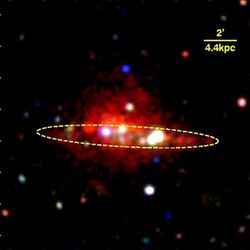
XMM-Newton view of hot ionised gas halo in NGC 4631. Image credit: ESA Click to enlarge
Astronomers using ESA’s XMM-Newton observatory have found very hot gaseous haloes around a multitude of spiral galaxies similar to our Milky Way galaxy. These ‘ghost-like’ veils have been suspected for decades but remained elusive until now.
Galaxy ‘haloes’ are often seen in so-called ‘starburst’ galaxies, the locations of concentrated star formation, but the discovery of high-temperature haloes around non-starburst spiral galaxies opens the door to new types of measurements once only dreamed about.
For example, scientists can confirm models of galaxy evolution and infer the star-formation rate in galaxies like our own by ‘calculating backwards’ to estimate how many supernovae are needed to make the observed haloes.
“Most of these ghost-like haloes have never been confirmed before in X-ray energies because they are so tenuous and have a low-surface brightness,” said Ralph T?llmann, from the Ruhr University in Bochum, Germany, lead author of the results.
“We needed the high sensitivity and large light-collecting area of the XMM-Newton satellite to uncover these haloes.”
In starburst galaxies, which have prominent haloes, star formation and star death (supernovae) are concentrated in the core of the galaxy and occur during a short time period over the life of a galaxy. This intense activity forms a halo of gas around the entire galaxy, similar to a volcano sending out a plume.
So how can haloes form in the absence of intense star formation? T?llmann’s group say that the entire disk of a spiral galaxy can ‘simmer’ with star-formation activity. This is spread out over time and distance. Like a giant pot of boiling water, the steady activity of star formation over millions and millions of years percolates outward to form the galaxy halo.
Two of the best-studied galaxies so far out of a group of 32 are NGC 891 and NGC 4634, which are tens of millions of light years away in the constellations Andromeda and Coma Berenices, respectively.
The scientists noted that these observations do not support a recent model of galaxy halo formation, in which gas from the intergalactic medium rains down on the galaxy and forms the halo.
Galaxy halos contain about 10 million solar masses of gas. The scientists say it is a relatively straightforward calculation to determine how many supernovae are needed to create the halo. Supernovae are intricately tied to the rate of star formation in a given galaxy.
“With our data we will be able to establish for the first time a critical rate of star formation that needs to be exceeded in order to create such haloes,” said Dr Ralf-J?rgen Dettmar, a co-author also from Ruhr University.
Once these haloes have formed, the hot gas cools and can fall down onto the galaxy’s disk, the scientists said. The gas is involved in a new cycle of star formation, because pressure from this infalling gas triggers the collapse of gas clouds into new stars.
Some heavy elements might escape the halo into intergalactic space, depending on the energy of the supernovae. Further analysis of the chemical composition of the halo might reveal this.
This would determine the correctness of recent cosmological models on the evolution of galaxies, as well as provide evidence of how the elements necessary for life are distributed through the Universe.
Original Source: ESA Portal
Buffy the Kuiper Belt Object
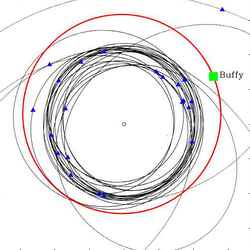
A view of Buffy’s and other Kuiper belt object orbits. Image credit: CFHT Click to enlarge
A team of astronomers working in Canada, France and the United States have discovered an unusual small body orbiting the Sun beyond Neptune, in the region astronomers call the Kuiper belt. This new object is twice as far from the Sun as Neptune and is roughly half the size of Pluto. The body’s highly unusual orbit is difficult to explain using previous theories of the formation of the outer Solar System.
Currently 58 astronomical units from the Sun (1 astronomical unit, or AU, is the distance between the Earth and the Sun), the new object never approaches closer than 50 AU, because its orbit is close to circular. Almost all Kuiper belt objects discovered beyond Neptune are between 30 AU and 50 AU away. Beyond 50 AU, the main Kuiper belt appears to end, and what few objects have been discovered beyond this distance have all been on very high eccentricity (non-circular) orbits. Most of these high-eccentricity orbits are the result of Neptune “flinging” the object outward by a gravitational slingshot. However, because this new object does not approach closer than 50 AU, a different theory is needed to explain its orbit. Complicating the problem, the object’s orbit also has an extreme tilt, being inclined (tilted) at 47 degrees to the rest of the Solar System.
The Discovery and Follow-up
The object, which received the official designation 2004 XR 190 in the International Astronomical Union’s official announcement, was discovered during routine operation of the Canada-France Ecliptic Plane Survey (CFEPS) running as part of the Legacy Survey on the Canada France Hawaii Telescope. For now, the discoverers are using the temporary nickname “Buffy” to identify the new object, although they have proposed a different official name in keeping with normal procedures for naming such objects.
Buffy was extracted from the mountain of Legacy Survey data (about 50 gigabytes per hour of operation) by powerful computers combing through the telescopic images and producing hundreds of candidates. Astronomers then sift through the candidates to identify the distant comets.
Astronomer Lynne Allen of the University of British Columbia was the first to lay eyes on the new object, as she completed the initial identification in the course of processing CFEPS data from December 2004. “It was quite bright compared to the usual Kuiper belt objects we find”, said Dr. Allen, “but what was more interesting was how far away it was.”
The object’s brightness implies it is likely between 500 and 1000 kilometers (300 to 600 miles) in diameter. Buffy is thus a very large Kuiper belt object, but about half a dozen are larger.
“We immediately realized that the object was about twice as far as Neptune from the Sun and that its orbit was potentially nearly circular,” said UBC professor Brett Gladman, who noticed the unusual nature of the object when determining its orbit, “but further observations were required.”
One to two years of observations of a Kuiper belt object are required before their orbits can be precisely measured. The first additional observations of Buffy came in October 2005 when Gladman and Phil Nicholson of Cornell University used the Hale 5-meter telescope to re-observe the object.
Measurement of Buffy’s new position proved that the orbit was not only extremely tilted, inclined (tilted) at 47 degrees to the plane of the planetary system (essentially tying the record for a Kuiper belt object) but confirmed that Buffy was unlike any other previously-known object because it was on a nearly circular orbit while at a very large distance.
More measurements of Buffy’s position on images from telescopes at Kitt Peak National Observatories in Arizona by team members Joel Parker (Southwest Research Institute), as well as JJ Kavelaars (National Research Council of Canada, Herzberg Institute of Astrophysics) and Wes Fraser (University of Victoria), through November 2005 refined the estimate for Buffy’s closest approach to the Sun. Additional observations, to further confirm the orbit, where then provided by the CFHT Legacy Survey project. Astronomers will need to wait until February 2006 to measure the fine details of the Buffy’s orbit.
The team have reported their find to the Minor Planet Center, the clearinghouse for astronomical measurements of new minor planets. “To find the first known object with a nearly circular orbit beyond 50 AU is indeed intriguing,” reacted Brian Marsden, director of the MPC.
Challenging Theories
Although it is neither the smallest, largest, nor most distant object discovered in this region, the new Kuiper belt object has a highly unusual orbit which challenges theories of the evolution of the Solar System.
Why is Buffy’s orbit considered so unusual? Only one other detected object, Sedna, remains further than 50 astronomical units (AUs) from the Sun throughout its entire orbit. However, Sedna is on a very elliptical orbit, swooping in to 76 AU before traveling back out beyond 900 AU. In contrast, Buffy spends all of its time in the narrow range between 52 and 62 AU from the Sun. Combined with the tilt in its orbit, this new object challenges current theories about the history of the early Solar System.
Astronomers have detected other Kuiper belt objects that spend most of their time beyond 50 AU. These are on very elliptical orbits, and almost all approach within 38 AU of the Sun. That close approach places those objects within the reach of the gravitational influence of Neptune. These objects are generally thought to have been scattered out to their present orbits by a gravitational slingshot with Neptune. This group of objects was thus called the “Scattered Disk”.
Prior to the discovery of Buffy, a few other Kuiper belt objects were discovered which spend much of their time beyond 50 AU like those in the “Scattered Disk”, yet did not approach within the gravitational reach of Neptune. This group has been named the “Extended Scattered Disk”. Two of its members are 1995 TL8 and 2000 YW134, which approach to 40 AU of the Sun but have fairly elliptical orbits that take them back out beyond 60 AU. Two more extreme examples of the “Extended Scattered Disk” are 2000 CR105, which approaches to 44 AU, and Sedna, which never comes closer to the Sun than 76 AU.
Due to their large eccentricities, these objects are likely to have been strongly perturbed by something, although it could not have been Neptune because they do not come close enough to be scattered by that planet’s gravitational force. As both Sedna and 2000 CR105 also travel beyond 500 AU from the sun, one theory is that after being scattered by Neptune, a passing star could have pulled their closest approaches away from the Sun.
Buffy is clearly a member of the “Extended Scattered Disk”. However, Buffy’s almost circular orbit makes it stand out from the other members. In addition, Buffy’s large orbital tilt is not so easily explained by the passing star idea. If a star could have affected Buffy so strongly, it should also have disrupted much of the main Kuiper belt as well. Since astronomers do not detect that strong disruption, a more complex theory is needed to explain Buffy’s orbit.
The elusive explanation may lie in side-effects from rearrangements of the Solar System early in its history. One possibility is that as Neptune’s orbit slowly expanded in the young Solar System, complex gravitational interactions could have caused some Kuiper belt orbits to circularize and tilt. While Buffy’s orbit could have been created this way, this theory would not seem to explain 2000 CR105 and Sedna. This new discovery is exciting because it causes us to rethink our understanding of how the Kuiper belt formed.
The Future
Over the last half decade, theories about the formation of our outer Solar System have been pushed to their limits: unusual Kuiper belt objects, like Buffy, which never come close to Neptune yet have high inclination must be explained.
Although theories that explain individual objects exist, reproducing the entire ensemble of known objects with one process poses a difficult challenge to current solar system models. Because the unusual objects, like Buffy, are very rare, astronomers are still scratching the surface of the dark corners of the Kuiper belt. Future large-scale surveys that systematically explore the Kuiper belt are the only way unlock the mysteries of what happened early in the history of our Solar System.
Original Source: Canada-France-Hawaii Telescope
Strange Bulge in Saturn’s Rings
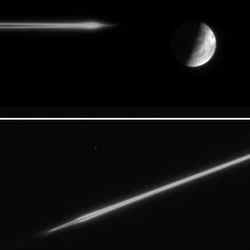
Saturn’s rings very close to edge-on. Image credit: NASA/JPL/SSI Click to enlarge
Viewing Saturn’s rings very close to edge-on produces some puzzling effects, as these two images of the F ring demonstrate.
The upper image was acquired from less than a tenth of a degree beneath the ringplane and shows a mysterious bulge. Such a feature has not been seen previously by the Cassini spacecraft from this angle. It is possible that, because of the very shallow viewing angle, the Cassini spacecraft’s view takes a long path through the ring, making very faint material visible. It also may be that an embedded object of a kilometer or so in size stirs up the neighboring ring particles to create a bulge. Alternatively, an impact into an embedded moonlet that was covered with debris could produce a cloud like this.
Images taken by the Voyager spacecrafts showed clumps that might have been produced in these ways. Cassini’s investigations will help to determine the vertical extent of such clumps and understand their origins.
The lower image was obtained from less than a hundredth of a degree beneath the ringplane. Across the center of the rings is a dark lane, giving them an appearance not unlike that of a spiral galaxy, seen edge-on.
Both images were taken using the clear spectral filters (predominantly visible light) on the Cassini spacecraft narrow-angle camera. The images have been magnified by a factor of two.
The top image was obtained at a distance of 3.6 million kilometers (2.2 million miles) from Saturn on Nov. 11, 2005 and shows wispy fractures on Dione’s trailing hemisphere. The image scale is 22 kilometers (14 miles) per pixel. The bottom image was acquired at a distance of 2.5 million kilometers (1.6 million miles) from Saturn on Nov. 5, 2005. The image scale is 15 kilometers (9 miles) per pixel.
The Cassini-Huygens mission is a cooperative project of NASA, the European Space Agency and the Italian Space Agency. The Jet Propulsion Laboratory, a division of the California Institute of Technology in Pasadena, manages the mission for NASA’s Science Mission Directorate, Washington, D.C. The Cassini orbiter and its two onboard cameras were designed, developed and assembled at JPL. The imaging operations center is based at the Space Science Institute in Boulder, Colo.
For more information about the Cassini-Huygens mission visit http://saturn.jpl.nasa.gov . The Cassini imaging team homepage is at http://ciclops.org .
Original Source: NASA/JPL/SSI News Release
Plasma Engine Could Open Up Space Exploration
![]()
Helicon reactor in operation. Image credit: ESA Click to enlarge
ESA has confirmed the principle of a new space thruster that may ultimately give much more thrust than today?s electric propulsion techniques. The concept is an ingenious one, inspired by the northern and southern aurorae, the glows in the sky that signal increased solar activity.
?Essentially the concept exploits a natural phenomenon we see taking place in space,? says Dr Roger Walker of ESA?s Advanced Concepts Team. “When the solar wind, a ?plasma? of electrified gas released by the Sun, hits the magnetic field of the Earth, it creates a boundary consisting of two plasma layers. Each layer has differing electrical properties and this can accelerate some particles of the solar wind across the boundary, causing them to collide with the Earth?s atmosphere and create the aurora.”
In essence, a plasma double layer is the electrostatic equivalent of a waterfall. Just as water molecules pick up energy as they fall between the two different heights, so electrically charged particles pick up energy as they travel through the layers of different electrical properties.
Researchers Christine Charles and Rod Boswell at the Australian National University in Canberra, first created plasma double layers in their laboratory in 2003 and realised their accelerating properties could enable new spacecraft thrusters. This led the group to develop a prototype called the Helicon Double Layer Thruster.
The new ESA study, performed as part of ESA?s Ariadna academic research programme in association with Ecole Polytechnique, Paris, confirms the Australian findings by showing that under carefully controlled conditions, the double layer could be formed and remains stable, allowing the constant acceleration of charged particles in a beam. The study also confirmed that stable double layers could be created with different propellant gas mixtures.
?The collaboration has been absolutely excellent,? says Dr Pascal Chabert, of Laboratoire de Physique et Technologie des Plasmas, Ecole Polytechnique. ?It has been a real kick-off for me and has given me lots of new ideas for plasma propulsion concepts to investigate with the Advanced Concepts Team. The new direction for our laboratory had led to a patent on a promising new electric propulsion device called an Electronegative Plasma Thruster.?
To create the double layer, Chabert and colleagues created a hollow tube around which was wound a radio antenna. Argon gas was continuously pumped into the tube and the antenna transmitted helicoidal radio waves of 13 megahertz. This ionised the argon creating a plasma. A diverging magnetic field at the end of the tube then forced the plasma leaving the pipe to expand. This allowed two different plasmas to be formed, upstream within the tube and downstream, and so the double layer was created at their boundary. This accelerated further argon plasma from the tube into a supersonic beam, creating thrust.
Calculations suggest that a helicon double layer thruster would take up a little more space than the main electric thruster on ESA?s SMART-1 mission, yet it could potentially deliver many times more thrust at higher powers of up to 100 kW whilst giving a similar fuel efficiency.
In the next steps, ESA will now construct a detailed computer simulation of the plasma in and around the thruster and use the laboratory results to verify its accuracy, so that the in-space performance can be fully assessed and larger high power experimental thrusters can be investigated in the future.
Original Source: ESA Portal
